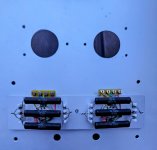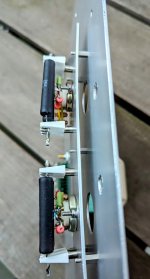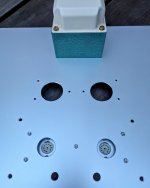Yes! I am hoping the tube holes will do the trick.... 🤞Hi Bas! Are you going to put the EL84 (and2A3) on a sub chassis, as you did with your previous build? Asking as with these power resistors and corresponding heat, you will want some big holes for proper ventilation.
But there will be more holes. For the filament controller board to name one.
Ok, lets see, and maybe measure. For my amps I made a cabinet with some openings at the top, and thought that "hot air raises" would be enough... One could barely keep one's hand in there, even OPTS were hot (absorbing radiation from the tubes). So I put 4 Noctua in the top plate running at half their nominal voltage, gently pulling air through the amplifiers (they are completely open, you know my building style), and now everything is cool. It surprised me how that hot air didn't move out on its own, even though the top and bottom had openings.
Yes. I've experienced that as well with my EL509 SE. Drilled a hole...did not help...the radiated heat was all absorbed by the aluminium top plate and boy did the top plate get hot....so I know it is deceiving. But I'll cross that bridge when I get there.and thought that "hot air raises" would be enough...
Tell me please more about the 509 SE?Yes. I've experienced that as well with my EL509 SE. Drilled a hole...did not help...the radiated heat was all absorbed by the aluminium top plate and boy did the top plate get hot....so I know it is deceiving. But I'll cross that bridge when I get there.
Private message OK too.
Steven
Actually. Just found and ordered some online: Searched for midden groen in Dutch. Vert moyen in French.
https://verfdiscounter.com/hammerite-metaallak-hamerslag-middengroen-0-25l.html
USA is in the dropdown. Not sure if they do send paint. Don't wanna get your hopes up for nothing.
https://verfdiscounter.com/hammerite-metaallak-hamerslag-middengroen-0-25l.html
USA is in the dropdown. Not sure if they do send paint. Don't wanna get your hopes up for nothing.
Get the output tubes warm and ready to draw Quiescent current.
Use a CLC B+ filter that has the tube rectifier's maximum specified first capacitor capacitance.
Now, turn on the B+ to the rectifier, to shock the rectifier into delivering maximum charge current for the B+ input capacitor, Plus the output tubes Quiescent current.
Some rectifiers are made so poorly that there are lumps/bumps in the filament's coating (direct heated filament, not cathode),
or on the cathode's coating.
The bump conducts more current, and you may get arcing at initial current, etc.
All designs have some kind of tradeoff or other.
Many old Hi Fi stereo tube amplifiers have been turned on and off every day, and playing for decades without any B+ delay (other than in some that use cathodes in the rectifier).
Trying to decide whether to design in "preventative fixes" is better decided when you know the complete circuit, and how it will be used.
Before designing in any intrinsic delay, or any delay circuitry, be sure to . . .
Analyze how well those circuits work when there is a "Hot Start". That occurs when your Power Mains Company drops the load (power goes off), and then quickly comes on again while all the tube filaments and tube cathodes are still warm.
Does the Harmon Kardon Citation II power amplifier, with those expensive KT88 or 6550 use B+ Delay?
I think they do not use delayed B+.
I am pretty sure the rectifiers are solid state.
Use a CLC B+ filter that has the tube rectifier's maximum specified first capacitor capacitance.
Now, turn on the B+ to the rectifier, to shock the rectifier into delivering maximum charge current for the B+ input capacitor, Plus the output tubes Quiescent current.
Some rectifiers are made so poorly that there are lumps/bumps in the filament's coating (direct heated filament, not cathode),
or on the cathode's coating.
The bump conducts more current, and you may get arcing at initial current, etc.
All designs have some kind of tradeoff or other.
Many old Hi Fi stereo tube amplifiers have been turned on and off every day, and playing for decades without any B+ delay (other than in some that use cathodes in the rectifier).
Trying to decide whether to design in "preventative fixes" is better decided when you know the complete circuit, and how it will be used.
Before designing in any intrinsic delay, or any delay circuitry, be sure to . . .
Analyze how well those circuits work when there is a "Hot Start". That occurs when your Power Mains Company drops the load (power goes off), and then quickly comes on again while all the tube filaments and tube cathodes are still warm.
Does the Harmon Kardon Citation II power amplifier, with those expensive KT88 or 6550 use B+ Delay?
I think they do not use delayed B+.
I am pretty sure the rectifiers are solid state.
Last edited:
Not a lot of progress. I cut into my right hand thumb (I'm righthanded) with an angle grinder. Nothing serious...but it happened on the top of my thumb very sensitive. Don't ask me how because I don't know. It's all a blur. Bought my self cut resistant gloves the same day.

Gloves and rotating tools aren't always a good combo. A fiber can wrap around a spindle and pull the hand towards the cutter.
Best to use the tool in a safe manner to start. Always clamp your work, use all guards that come with the tool, plan well and don't rush.
Hope you recover soon.
Best to use the tool in a safe manner to start. Always clamp your work, use all guards that come with the tool, plan well and don't rush.
Hope you recover soon.
- Home
- Amplifiers
- Tubes / Valves
- Building parafeed EL84 DC 2A3 amp


